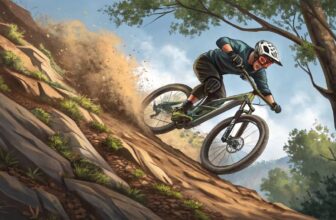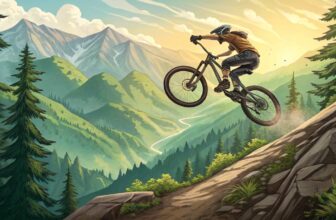Riding a mountain bike is not just a hobby; it is a thrilling adventure that demands precision, resilience, and optimal performance from both the rider and their equipment. To elevate your mountain biking experience to new heights, investing in strategic upgrades can transform your ride, enhancing both efficiency and enjoyment.
This comprehensive guide will explore the essential upgrades every mountain bike enthusiast should consider, ensuring that each component is prioritized for maximum impact.
Whether you’re seeking to increase durability, boost speed, or simply enhance the overall comfort of your ride, these expertly recommended upgrades will empower you to conquer any trail with confidence and finesse.
Sprucing Up Your Mountain Bike Ride
Getting the most out of your mountain bike kinda hinges on tweaking some key bits and bobs. The two big fish here are how much oomph you’re giving (yep, that’s you pedaling hard) and fiddling with those gears to make your ride as smooth as a baby’s bottom on all terrains.
Power Source Output
When they say pedal power, they ain’t kidding. The faster your legs crank, the more juice your bike gets. Here’s how to kick it up a notch:
- Pedal Power: If you wanna see speed, think of strong legs and top-notch endurance. Hit those trails often to build up those tree-trunk thighs and lungs of steel.
- Fit Matters: You, your bike—like peanut butter and jelly. A right fit means every ounce of energy goes straight to the wheels. Check this out about bike fits and sizes.
- Swap Stuff Out: Flashy new wheels or a snappy drivetrain? Not just for show, they lighten the load, making it easier to fly down the track.
| Power Factor | Impact on Riding Fast |
|---|---|
| Buff Rider | High Octane |
| Right Fit | Middle of the Road |
| Fancy Components | Middle of the Road |
Gearing Tweaks
Messing around with your gears isn’t just for the tech-heads. It’s key to keeping things fast and smooth whether you’re burning rubber or steep climbing.
- Stretch Those Gear Ratios: Adjusting gear ratios keeps you cruising faster or huffing less up hills. Lower ratios ease climbing, while higher ones help you zoom across flats.
- 1x Drivetrain: Get a handle on that one-ring gig out front. It’s lighter and cuts out the faff, so gear shifts are as slick as oil on a slide (1x mtb conversion).
- No More Clunking: Dial in gear indexing to keep that chain in check and feel the ride glide.
| Gear Tweaks | What You Get |
|---|---|
| Better Gear Ratios | Speed and Easy Riding |
| Lighter Drivetrain | Less Weight, More Fun |
| Smooth Indexing | No Bumps Shifting |
Give these changes a go, and you’ll feel your MTB game’s gone up a gear. For more tricks and tips on sprucing up or fixing your ride, swing by mountain bike maintenance and get handy with diy repairs.
Personal Fitness Impact
Fitness Level & Speed
When it comes to mountain biking, your fitness level is like that secret sauce for zipping around with power. Maintaining a steady speed of 30 mph on flat ground calls for more oomph than most folks can muster (Quora).
Want to crank up your speed? Step up your fitness game! With improved fitness, you’ll notice your rides becoming more efficient, possibly outperforming those fancy-pants bikes splashed across cycling magazines (Quora).
Our energy levels play a big part when we’re pedaling hard, and being fit really helps in keeping up the pace. Here’s a quick glance at how power aligns with your speed:
| Speed (mph) | Power Output (watts) |
|---|---|
| 10 | 30-40 |
| 15 | 80-100 |
| 20 | 160-200 |
| 25 | 290-350 |
| 30 | 480-550 |
These numbers are like best guesses and can change with conditions like weight and terrain.
Compatibility with New Components
Thinking of jazzing up your older mountain bike? Go for it, but make sure those shiny new parts fit like a glove or you’ll be disappointed. Frame size is a biggie here. Imagine trying to wiggle a 1-inch steerer tube into a high-tech fork that’s just not having it! And don’t forget tire size compatibility—those 2.3-inch tires need room to breathe (Quora).
For a significant boost, focus on these front-row parts:
- Suspension system
- Gear setup
- Wheels
- Brake setup
- Tires
Keep in mind, you don’t want to swap out too many original bits, like wheels or gears, since you could end up with a bike that’s more franken-bike than an upgrade (Quora).
To ensure it all clicks:
- Double-check new parts against your bike’s measurements.
- Make sure things like gears and brakes don’t just fit but actually play nice together.
- Get advice from a pro or dive into mtb drivetrain compatibility and mtb gear indexing guides for an extra edge.
Tuning up fitness and picking compatible parts mean a better biking journey, whether you’re upgrading what you’ve got or snagging some fresh gear. For more on keeping your ride in top shape, check out our guide on mountain bike maintenance.
Upgrading Mountain Bike Components
Thinking about souping up your mountain bike? Let’s chat about two biggies: disk brakes and suspension forks. These upgrades can give your ride a serious boost in both performance and handling. More fun and efficiency on the trails, anyone?
Disk Brakes Consideration
Disk brakes are the biker’s choice for those who crave better stopping power, come rain or shine. That said, before you jump on the brake bandwagon, you’ve got to check if your frame can hack it.
- Frame Compatibility: Make sure your bike’s frame has the right mounts for disk brakes. On older models that came with rim brakes, you might find no place to fit those new brakes due to missing mounting points or special frame dropouts. Something to keep in mind so you don’t end up with a fancy new brake and nowhere to put it.
- Fractions and Figures: If disk brakes aren’t naturally part of your bike’s DNA, you might want to rethink throwing your cash there. Other upgrades like switching to a trendy 1×12 or 2×12 gear setup or popping on a dropper post might offer more bang for your buck (mountain bike gear ratios, mountain biking essentials).
| Upgrade | Compatibility | Estimated Cost |
|---|---|---|
| Disk Brake Conversion | Needs disk brake mounts | $150 – $300 |
| Dropper Post | Fits most seat tubes | $100 – $400 |
| 1×12/2×12 Drivetrain | Works with most frames | $200 – $600 |
Suspension Fork Upgrade
Thinking of swapping out that rigid fork? An upgrade here can give you a plush ride over the bumps and boulders. With the right suspension fork, you’ll feel like the king of the trail.
- Ride in Comfort: A good suspension fork keeps the trail gremlins at bay, absorbing those jolts and jitters. Feel the trail, not the turbulence (mtb suspension setup).
- Tackle the Tough Stuff: A new suspension fork can turn a bumpy ride into a buttery one, helping you dance through the rock garden like a pro (Quora).
- Get Some Speed: Sure, a suspension fork might add a tad more weight. But on the downhill, it’ll have you gliding like a falcon, navigating twists and turns with the greatest of ease (riding rock gardens mtb).
| Suspension Fork Type | Benefits | Estimated Cost |
|---|---|---|
| Air Suspension | Light and adjustable | $200 – $800 |
| Coil Suspension | Comfy ride, tough as nails | $150 – $600 |
| Hybrid | Best of both worlds | $300 – $1000 |
If you’re itching to up your game on the trails, disk brakes or a new suspension fork could do wonders for your ride. Just make sure your current setup can handle the upgrade, or consider some other mods that make sense for you. For a deeper dive into mountain bike care and tweaking, peep our guides on mtb fork maintenance, how to clean mountain bike, and diy mountain bike repairs.
Benefits of Suspension Fork Upgrade
Swapping out your mountain bike’s suspension fork can seriously amp up your trail adventures. Besides giving your bike a snazzy makeover, it preps you for tackling bumpy terrains like a pro.
Aesthetic & Riding Experience
A suspension fork isn’t just eye candy for your bike – though it certainly adds that rugged look – it’s a game changer on the trails, making your ride feel like a smooth adventure roller coaster. Its bouncy magic takes a regular ride and turns it into a lively escape. Youngsters and spirited bikers alike will notice a boost in smoothness and reaction time.
Good Vibes of a Suspension Fork:
- Eye Candy: Transforms your bike with a sturdy, pro look.
- Boing Factor: Cranks up enjoyment on your ride.
- Rider Ease: Softens the blows to your body, making jaunts longer and less punishing.
Even with a tad extra weight, you’ll blaze through rocky trails faster, thanks to stellar shock handling. Check out tips on honing your mountain biking skills for more about this sweet ride.
Handling Rough Terrains
The superstar feature of the suspension fork is its knack for gobbling up rough trails like rocks, roots, and drops. By absorbing shocks, it subtracts a lot of ouch from your ride. You’ll love how it ups your control, making dips and turns not just manageable but downright fun.
How Suspension Forks Munch Terrain:
- Shock Snack: Eats up jolts from bumps and drops.
- Trail Feel: Lets you grip and zoom better on tough tracks.
- Tire Grip: Maximizes grip, letting you charge ahead confidently.
Switching gears to a suped-up suspension fork gives your bike the chops to own those gnarly paths. Feel the smooth control swooping down without fiddling to dodge rough patches (The Pros Closet). To wring every drop of performance out of your fork, peek at our guide on mtb suspension setup.
If you’re eyeing this upgrade, double check that your bike frame size and other bits and pieces mesh with the new fork. Plus, a bit of bike maintenance love goes a long way in getting the max from your suspension fork makeover.
Factors to Consider Before Upgrading Fork
Getting a new suspension fork can really rev up your mountain biking experience, but before you dive in, there are several things you gotta think about. Here, we’ll chat about fork compatibility and how it can amp up your skill level.
Fork Compatibility
Getting the right fit is key when you’re swapping out your suspension fork. Make sure the new one plays nice with your bike’s frame and sizing details. Nobody wants a fork that doesn’t fit like a glove.
Things to Keep in Mind:
- Steerer Tube Size: Gotta check if the fork’s steerer tube can get along with your bike’s setup.
- Axle Type: Your wheels and fork should be on the same page. Are you working with a quick release or thru-axle?
- Travel Length: The fork’s travel should match your bike’s style and what you’re gonna use it for.
| Things to Watch For | What to Think About |
|---|---|
| Steerer Tube Size | Matches with your headset |
| Axle Type | Quick release or thru-axle? |
| Travel Length | Fits your bike’s geometry |
If your new fork is a good fit with your bike, you’ll dodge issues that might cramp your ride. Peep our guide on MTB drivetrain compatibility for more info on keeping things running smoothly.
Skill Level Boost
Getting yourself a top-notch suspension fork can seriously level up your riding game. A good fork lets you handle bumpy trails like a pro, boosting how you ride overall.
Perks of a Skill Upgrade:
- Traction and Control: Better grip means you’ll handle those descents like a champ.
- More Comfort: Shocks from bumpy trails won’t wear you out as much.
- More Confidence: Ride like you own those technical parts.
Switching forks can up your speed and nimbleness, especially when you’re barreling down rocky slopes. A well-fitted suspension means smoother, sometimes faster rides.
| Skill Perk | What’s in it for You |
|---|---|
| Better Traction | More control, like glue on tires |
| Greater Comfort | Less beat-up from trail roughness |
| Increased Confidence | Handle tricky spots better |
For those already rocking it out there, upgrading to a sweet suspension fork could turn your bike into a beast that chews up rocks and crushes drops.
Check out our articles on mtb line choice and mountain biking basic skills to fine-tune your riding and squeeze every last benefit from your new fork setup.
Maximizing Suspension Performance
Upgrading your mountain bike’s suspension fork is like adding sprinkles to your ice cream—it’s not necessary, but boy, does it make the ride sweeter!
Plunging into rugged terrains and daredevil trails transforms into an exhilarating rush. But hang on a minute, just slapping a fancy fork onto your ride won’t magically turn you into Superman. Nope, it requires some fiddle-faddling with initial setup and a pinch of routine maintenance. Oh, and honing your skills plays a big role too—it’s all about getting cozy with your shiny new suspension.
Initial Setup & Maintenance
Start off on the right foot by giving your mountain bike suspension setup some TLC. Here’s what to keep in mind:
- Sag and Rebound Adjustment: Think of sag like your GPS—it helps you navigate the ride with ease. Aim to set the sag at about 20-30% of your fork’s travel. Now, onto the rebound, which dictates how swiftly the suspension claws its way back up after soaking up a bump. Dial it in for a nice, smooth return, taming those tricky paths like a pro.
- Regular Servicing: To keep things as smooth as butter, engage in a little suspension pampering at least once a year. We’re talking cleaning, lubricating, and giving your fork some love. There’s a treasure trove of mountain bike maintenance and bike cleaning guides you should scope out when you’ve got a second.
- Routine Setup Checks: Treat your bike to frequent little check-ups: ensure air pressures are spot on, seals are snug, and there are no oil-exulting leaks. Tackling the small stuff early will save you from a world of pain later on.
Practicing Riding Skills
Even the flashiest suspension won’t impress anyone if your riding skills are rusty. Here’s how to get the most outta that upgrade:
- Mastering Basic Techniques: Become buddies with the basics like balance, body positioning, and cornering. These skills are like the bread to your butter, making sure your suped-up suspension doesn’t go to waste. Dive into mountain biking basics to get started.
- Riding Different Terrains: Playing around on various grounds gives you a sneak peek into your suspension’s personality under different circumstances. It reveals how to tweak settings for that dream ride.
- Advanced Techniques: Fancy getting airborne? Or maybe just stopping without face-planting? Check out how to jump your MTB and nail braking techniques to challenge your ride’s boundaries.
- Trail-Specific Skills: Brush up on your rock garden navigating skills or channel your inner Spiderman on those technical climbs. Try your hand at riding rock gardens, and technical climbing, and perfect those drop techniques.
Armed with a stellar setup and sharpened skills, you’ll turn every ride into an epic adventure, no matter the trail shenanigans. Use our guides for mtb fork maintenance and mtb suspension setup to keep your bike tip-top, ready for whatever daring detours you dream up next.
Choosing the Right Mountain Bike
Picking a mountain bike isn’t just a matter of taste—it’s your ticket to a better ride, whether you’re buying your first bike or you’re an old pro swapping up. The right choice cranks up the fun factor, giving you comfort, control, and durability wherever you ride.
Frame Size & Fit
Getting the right frame size is all about staying comfy and in control. A bike that fits just right makes all the difference in handling, cutting down on any aches or risks. Match your bike size with your height and inseam. Most bike brands offer size charts to aid your decision.
| Rider Height (ft/in) | Frame Size (in) | Frame Size (cm) |
|---|---|---|
| 4’10” – 5’2″ | 13″ – 14″ | 33 – 40 cm |
| 5’3″ – 5’6″ | 15″ – 16″ | 40 – 45 cm |
| 5’7″ – 5’10” | 17″ – 18″ | 45 – 50 cm |
| 5’11” – 6’2″ | 19″ – 20″ | 50 – 55 cm |
| 6’3″ – 6’6″ | 21″ – 22″ | 55 – 60 cm |
Need more guidance? Drop by our mountain bike frame sizes page for detailed info.
Suspension Selection
Suspension is your buddy on bumpy roads, smoothing out your rides. The right suspension choice depends on where you plan to wheel around. The art is in the suspension travel, usually between 100mm and 200mm, which cushions your ride and holds the ground tight.
Hardtail vs. Full Suspension
- Hardtail Bikes: They only have front suspension, weighing less on your wallet and scale. Hardtails shine on cross-country routes and tame trails.
- Full Suspension Bikes: Suspension at both ends means they’re ready for wild terrains and downhill thrills, offering enhanced comfort and control.
| Suspension Type | Best For | Suspension Travel (mm) |
|---|---|---|
| Hardtail | Cross-country, milder trails | 100mm – 120mm |
| Full Suspension | Rough terrains, downhill | 140mm – 200mm |
Craving more details? Bounce over to our MTB suspension setup article for the nitty-gritty on suspension.
Additional Considerations
Pimp your ride to fit your riding style with these pointers:
- Weight: Lighter frames put you in charge.
- Durability: Strong materials make for a tough-as-nails bike.
- Adaptability: Check if everything aligns with fresh components (mtb drivetrain compatibility).
Keep your bike in top shape with regular TLC, like checking out our how to clean mountain bike guide.
Choosing the right mountain bike means getting the frame, fit, and suspension that clicks for you, making every trail a breeze to conquer.
Maintenance Tips for Mountain Bikes
Keeping your mountain bike in tip-top shape isn’t rocket science, but a little elbow grease goes a long way. Think of it like pampering your ride for its next adventure. Here’s the scoop on making sure your two-wheeled buddy is ready to roll.
Cleaning & Maintenance Checks
You wouldn’t take a mud-covered dog through your living room, right? The same goes for your bike. Regular sprucing keeps everything running slick.
1. Cleaning Your Bike
- Mud and grime be gone! Give your bike a rub-down with the hose, and soap it up with a gentle cleaner.
- Scrub-a-dub with a soft brush on the frame, wheels, and drivetrain to tackle any stubborn dirt.
- Make sure it’s bone dry when you’re done to keep rust at bay.
2. Maintenance Checks
- Peek at your suspension system—are any creaks or cracks showing up?
- Keep those tires firm and bouncy. For deets, check our mtb tire pressure.
- Are your brakes ready to stop you on a dime? Dive into our mountain bike brakes comparison for more info.
3. Lubrication
- Keep your chain and moving bits slick with some lube. Nobody likes a squeaky bike.
- Wipe off extra lube so it doesn’t turn into a dirt magnet.
Want a deep dive into getting your bike spick and span? See our how to clean mountain bike for more juicy details.
Drivetrain Component Replacement
The drivetrain—your bike’s power player. Wear and tear happen to the best of us. Let’s chat about keeping yours in working order.
1. Checking Drivetrain Components
- Is your chain looking a bit droopy or stretched? It’s probably calling for a replacement.
- Toothless wonders are not cool. If your cassette and chainrings look gnawed, it’s time for new ones.
- Odd clinks and clanks? Your components might be whispering, “Help!”
2. Replacing Drivetrain Parts
- Swap chains every 1,000 to 3,000 miles, depending on how hard you ride.
- Cassettes and chainrings also bow out eventually—replace them when needed.
- Upgrading parts isn’t just for show; it boosts performance. Our MTB drivetrain compatibility guide has got your back for picking new gear.
| Drivetrain Component | When to Replace |
|---|---|
| Chain | 1,000 – 3,000 miles |
| Cassette | 3,000 – 5,000 miles |
| Chainring | 5,000 – 7,000 miles |
Keeping your mountain bike in shape is more than just chores; it’s about making every ride awesome. For more handy advice, check out our mountain bike maintenance section. Frequent check-ups and timely part swaps are your ticket to smooth trails, whether you’re a city cruiser or dirt trail die-hard.
Conclusion
Upgrading your mountain bike is more than just a tweak; it’s a transformation that enhances every aspect of your ride.
From boosting your pedal power and fine-tuning your gears to selecting the perfect suspension fork and maintaining optimal bike health, each improvement plays a pivotal role in elevating your biking performance and enjoyment.
By investing in the right components and accessories, you not only ensure a smoother and more efficient ride but also extend the lifespan of your bike.
Embrace these upgrades and gear recommendations to revolutionize your MTB experience, making every trail an exhilarating adventure. Ready to ride smarter and stronger? Start upgrading today and feel the difference on every path you conquer.
Frequently Asked Questions (FAQs)
What are the most important upgrades for a mountain bike?
Key upgrades include improving pedal power, optimizing gear ratios, upgrading to disk brakes, enhancing the suspension fork, and ensuring proper bike fit.
How does upgrading the suspension fork improve my ride?
A better suspension fork absorbs shocks more effectively, providing smoother rides over rough terrains, improving control, and reducing rider fatigue.
Are disk brakes worth the investment for mountain biking?
Yes, disk brakes offer superior stopping power in all weather conditions, enhancing safety and performance on varied trails.
What maintenance tools are essential for mountain bike upkeep?
Essential tools include a multi-tool, chain cleaner and lubricant, tire levers, a pump, and a portable bike stand for easy maintenance.
How can I ensure my bike upgrades are compatible?
Always check the compatibility of new components with your bike’s frame size, suspension type, and existing parts. Consulting manufacturer specifications or a professional bike mechanic can help.




